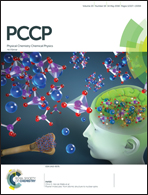Chemo-mechanical coupling in kerogen gas adsorption/desorption
Abstract
Kerogen plays a central role in hydrocarbon generation in an oil/gas reservoir. In a subsurface environment, kerogen is constantly subjected to stress confinement or relaxation. The interplay between mechanical deformation and gas adsorption of the materials could be an important process for shale gas production but unfortunately is poorly understood. Using a hybrid Monte Carlo/molecular dynamics simulation, we show here that a strong chemo-mechanical coupling may exist between gas adsorption and mechanical strain of a kerogen matrix. The results indicate that the kerogen volume can expand by up to 5.4% and 11% upon CH4 and CO2 adsorption at 192 atm, respectively. The kerogen volume increases with gas pressure and eventually approaches a plateau as the kerogen becomes saturated. The volume expansion appears to quadratically increase with the amount of gas adsorbed, indicating a critical role of the surface layer of gas adsorbed in the bulk strain of the material. Furthermore, gas uptake is greatly enhanced by kerogen swelling. Swelling also increases the surface area, porosity, and pore size of kerogen. Our results illustrate the dynamic nature of kerogen, thus questioning the validity of the current assumption of a rigid kerogen molecular structure in the estimation of gas-in-place for a shale gas reservoir or gas storage capacity for subsurface carbon sequestration. The coupling between gas adsorption and kerogen matrix deformation should be taken into consideration.



 Please wait while we load your content...
Please wait while we load your content...